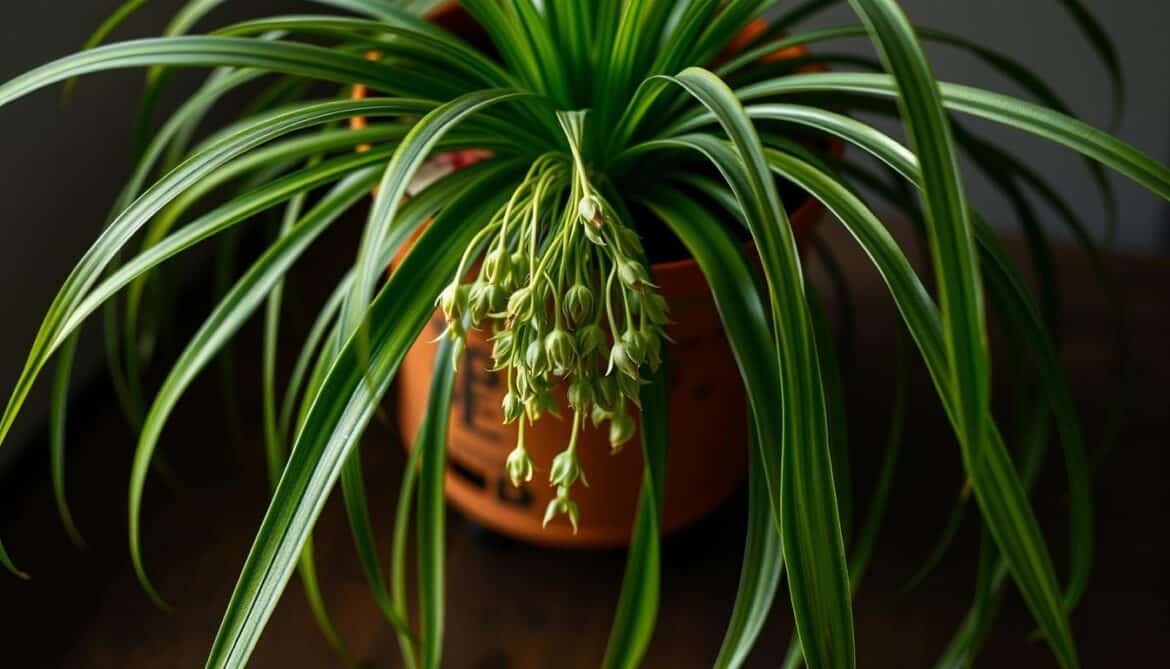Watching a spider plant grow into a family is magical. Those little plantlets hanging from stems are not just cute. They’re a key to a thriving indoor garden.
Whether you’re starting with your first baby or want to grow more, spider plant propagation is easy. These plants need sunlight, water, and a chance to root. By taking care of them, you’ll get free new plants, cleaner air, and the joy of watching life grow.
Key Takeaways
- Spider plant babies grow quickly and require minimal effort to root successfully.
- Spider plant propagation methods work with water, soil, or even indirect light.
- Proper spider plant care ensures healthy growth and prevents common issues like browning leaves.
- Spider plant babies purify air naturally, improving home environments.
- Creative displays like hanging baskets highlight their unique appearance.
Understanding Spider Plants and Their Babies
Spider plants (Chlorophytum comosum) are known for their toughness and unique way of growing. They send out stolons, long stems, from their base. These stems end in small spider plant babies, or spider plant pups. Native to Africa, this helps them spread in the wild. But indoors, these babies are a chance for growth and care.
What Are Spider Plant Babies?
Spider plant babies are tiny versions of the mother plant. They grow on long stems, often hanging over pots. Each baby has roots that grow while attached to the mother. This is a key part of their biology, helping them thrive in different places without help.
The Importance of Propagation
- Rejuvenates mother plants by reducing overcrowding.
- Creates new plants for sharing or expanding your collection.
- Prevents root stress in crowded containers.
Propagating spider plant babies helps them grow healthy and strong. By separating pups early, each plant gets room to grow. This also makes the original plant live longer, growing lush and full.
How to Identify Spider Plant Babies
Spotting spider plant babies is essential for successful propagation. These small plants, known as spider plant pups, grow differently than the adult leaves. Here’s what to look for:
Distinguishing Between Baby and Mature Plants
- Size: Spider plant babies are small rosettes, while mature plants have bigger, wider leaves.
- Growth location: Pups grow on long stems called stolons, unlike the mother plant’s central base growth.
- Leaf shape: Babies have delicate, pointed leaves, unlike the broader, flat leaves of mature plants.
Signs of a Healthy Spider Plant Baby
| Healthy Signs | Unhealthy Signs |
|---|---|
| Firm, upright leaves | Wilting or soft leaves |
| Vibrant green color | Yellow or brown edges |
| Short visible roots at base | No root growth or rotting roots |
Healthy pups show these signs and are ready for propagation. Wait until they’re at least 3 inches tall before separating them. Proper spider plant baby care starts with accurate identification to avoid damaging the mother plant.
Propagation Methods for Spider Plant Babies
Learning spider plant propagation begins with picking the right method. These techniques help plants grow well and root deeply:
Offsets Method
Allow spider plant babies to stay with the mother plant until they develop roots. Cut the stems close to the base with sharp shears. Then, put the offset in moist soil, keeping it damp but not wet. This propagating spider plants method does best in indirect light.
Water Propagation
Put the baby plant’s roots in a glass of filtered water. Change the water every 3–4 days to avoid rot. Roots will grow in 2–3 weeks. When roots are 2 inches long, move the plant to soil for more growth.
- Use clear containers to watch root growth
- Place near east-facing windows for best light
Soil Propagation
Plant baby plants in a well-draining soil mix. Water well after planting and cover the pot with a plastic bag to keep humidity in. Remove the bag when new leaves start to grow. For the best results, follow ChikusGarden’s guide to avoid harming the roots.
Each method has its own advantages. Offsets do well when left connected longer. Water propagation lets you see root growth. Soil propagation gives plants stability right away but needs careful spider plant baby propagation timing. Try out these methods to see which one works best for you.
Optimal Conditions for Spider Plant Babies
Starting with the right environment is key for spider plant baby care. These plants do well but grow best with specific light, temperature, and soil. Follow these tips for healthy growth in their early days.
Light Requirements
Spider plant babies need bright, indirect light to grow strong. Put them near east- or north-facing windows to avoid direct sun. If it’s too dark, use artificial grow lights. Like peppers, they can handle some shade but grow slower in dark places.
Temperature and Humidity
Keep temperatures between 60-75°F (15-24°C) for best growth. They like moderate humidity but can handle indoor levels. Mist them sometimes or use a pebble tray to increase moisture. Stay away from drafty spots near heaters or air vents.
Soil Preferences
Choose loose, well-draining soil mixes for growing spider plant babies. Mix potting soil with perlite or sand to prevent waterlogging. Heavy soils can cause root rot, so avoid them.
- Use pre-mixed cactus soil or add 1 part sand to 3 parts potting mix
- Check soil moisture before watering to avoid overwatering
Adjusting these factors helps your spider plant babies grow strong and lush. Small changes in light and soil can greatly improve their health.
Watering Spider Plant Babies
Spider plant baby care needs careful attention to moisture. Overwatering is a common mistake that harms growing spider plant babies. Learn how to water properly to keep your plants thriving.
Healthy spider plant care starts with understanding their watering needs. New babies need consistent moisture but avoid soggy soil. Adjust frequency based on season and environment.
How Often to Water
- Check soil moisture by poking 1 inch deep. Water when dry.
- Water less in winter; increase in summer when soil dries faster.
- Use pots with drainage holes to prevent waterlogging.
Signs of Overwatering
Spot issues early with these symptoms:
| Symptom | Cause | Solution |
|---|---|---|
| Yellow lower leaves | Root suffocation from excess water | Wait until soil is fully dry before next watering. |
| Soft, translucent stems | Root rot developing | Repot in fresh, dry soil and trim rotted roots. |
| Falling leaves | Prolonged overwatering stress | Reduce watering and improve drainage. |
Always prioritize well-draining soil and avoid letting pots sit in saucers of water. Proper watering ensures strong growth and avoids common pitfalls in spider plant care.
Fertilizing Spider Plant Babies
Spider plant babies need the right nutrients to grow well. Knowing when and how much to feed them is important. Too much fertilizer can damage their roots, so it’s all about finding the right balance.
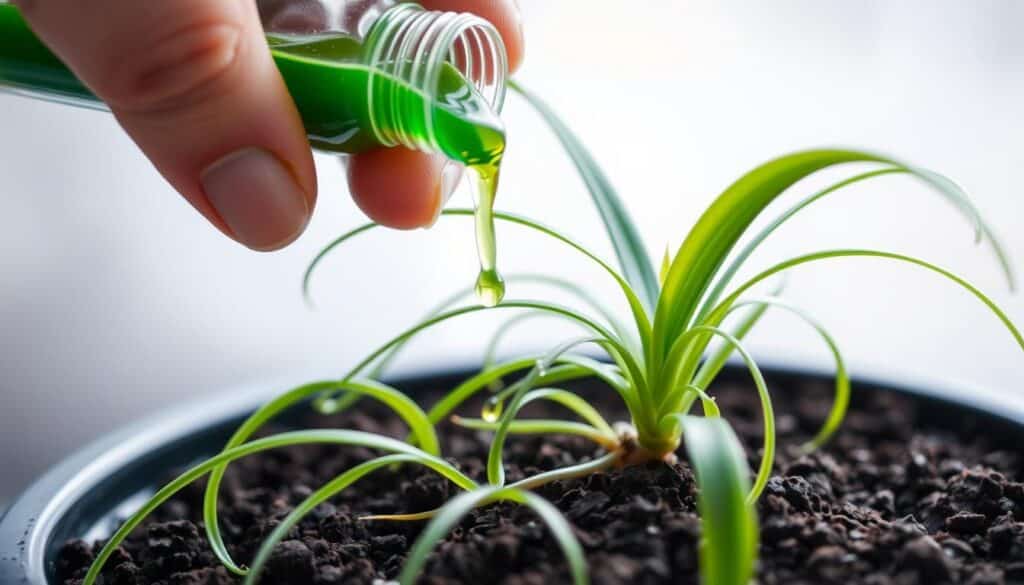
Types of Fertilizers
Opt for gentle fertilizers made for houseplants. Spider plant propagation tips suggest:
- Water-soluble 10-10-10 NPK fertilizer diluted to half strength
- Organic options like compost tea or worm castings
- Slow-release pellets for gradual feeding
Fertilizing Schedule
Here’s a simple guide to keep your plants healthy:
| Stage | Frequency | Notes |
|---|---|---|
| Newly propagated | First feeding after 4-6 weeks | Wait until roots stabilize |
| Active growth (spring/summer) | Every 6-8 weeks | Use diluted liquid fertilizer |
| Winter | Suspend feeding | Plants enter dormancy |
Spider plant care experts say to check soil moisture before fertilizing. Never fertilize dry soil. For more tips, check out Chikus Garden’s propagation guides. Also, rinse soil monthly to avoid salt buildup from synthetic fertilizers.
Common Issues with Spider Plant Babies
Spider plant baby care needs careful watching for early signs of trouble. Even with the right spider plant propagation tips, pests or diseases can show up. Regular checks help solve problems before they get worse.
Pests to Watch For
Spider plant babies can attract several pests:
- Spider mites: Tiny, spider-like dots on leaves. Wash with neem oil or a water spray.
- Aphids: Clusters under leaves. Use insecticidal soap or alcohol swabs.
- Mealybugs: White cottony patches. Wipe with a cotton ball dipped in rubbing alcohol.
Common Diseases and Solutions
Overwatering can cause root rot, turning leaves yellow or mushy. Let the soil dry between waterings. Brown leaf tips might mean too much fluoride in the water—use distilled water instead.
Fungal spots need better airflow and pruning. Stunted growth might mean a lack of nutrients. Adjust spider plant care by repotting in fresh soil.
Always keep infested plants separate and disinfect pots to stop the spread. Natural remedies are best, but severe cases might need commercial pesticides.
Repotting Spider Plant Babies
Repotting is key for your spider plant babies to grow well. It’s all about spider plant baby care. You need to know when and how to move them to bigger pots. This supports their roots and health.
When to Repot
Look out for these signs your plant needs a new home:
- Visible roots poking through drainage holes or soil surface
- Slowed growth despite regular spider plant care
- Soil dries out unusually fast
- Plant leans or becomes unstable
Most plants need a new pot 6–12 months after they start growing. But always listen to your plant’s specific needs.
How to Repot Safely
Here’s how to repot your plant successfully:
- Select a pot: Pick a container 2–3 inches wider than the current one. Make sure it has drainage holes. Clay or plastic pots are good choices.
- Prepare soil: Use a well-draining potting mix. Check out this propagation guide for more tips.
- Remove gently: Tip the pot sideways and carefully take out the plant. Gently loosen any tangled roots.
- Position and fill: Put the plant in the new pot. Add fresh soil around the roots and press gently.
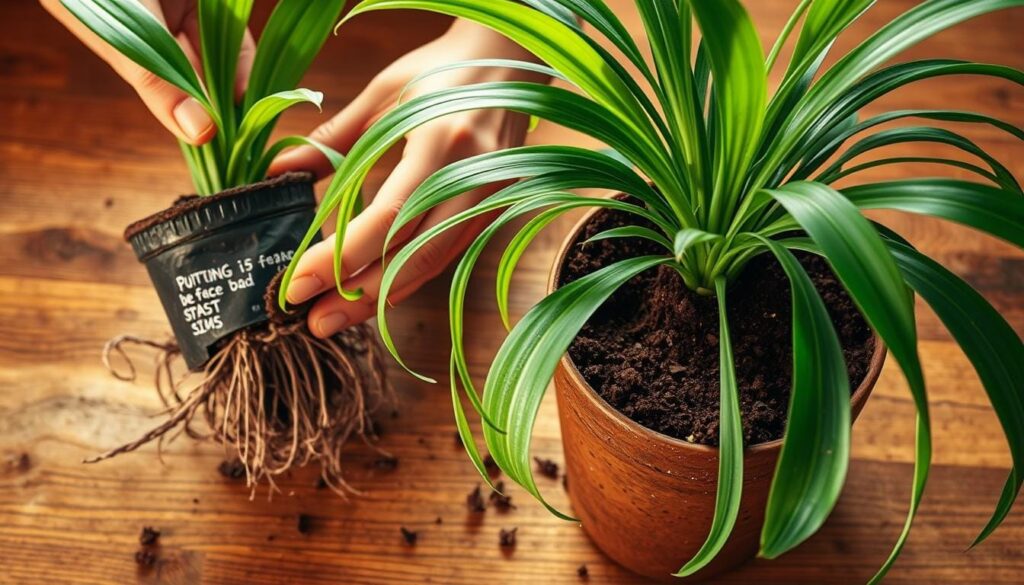
After repotting, water lightly and put it in bright indirect light. Don’t fertilize for 2–3 weeks to let the roots settle. Proper repotting helps your growing spider plant babies stay healthy and avoid root stress.
Adjusting Care as Spider Plant Babies Grow
Spider plant babies need different care as they grow. Look for healthy roots and bigger leaves to know when to make changes. Watching their growth helps you care for them well from start to finish.
Transitioning to Independence
When roots fill the pot and leaves get bigger, it’s time for them to grow up. Start by watering them less often. Also, cut back on fertilizers to prevent too much food.
Make sure the soil drains well, like for aloe vera plants. This stops rot. For more tips, check out this aloe revival tutorial.
- Check soil dryness 1-2 inches deep before watering.
- Allow leaves to harden as a sign of resilience.
Revising Water and Sunlight Needs
As they get older, spider plants need less water but more sunlight. Adjust their care to match their growth for the best results.
- Water every 7-10 days instead of weekly as roots stabilize.
- Move to brighter spots with indirect light to boost growth.
Changing their care helps them grow naturally. Watch for yellow or wilted leaves to avoid making mistakes.
Creative Ways to Display Spider Plant Babies
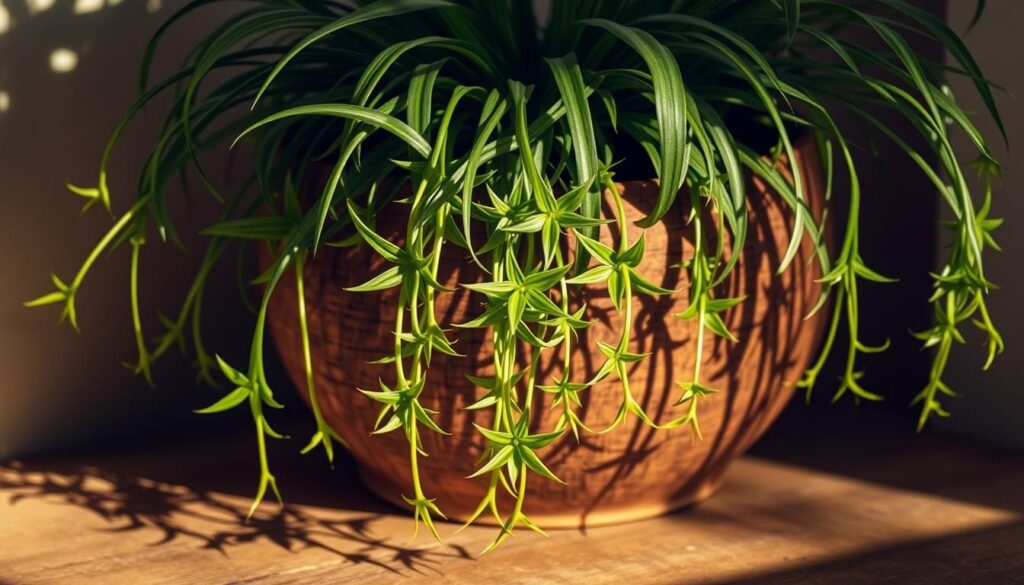
Spider plant babies bring charm to any room and grow well with the right care. Find creative ways to show off their beautiful leaves and stems.
Hanging Basket Ideas
Hang spider plant babies to let their long runners flow freely. Try:
- Macramé hangers for a bohemian look
- Wall-mounted tiered plant stands for vertical flair
- Transparent glass orbs to see aerial roots
Put them near bright, indirect light. East-facing windows are perfect. Mix with trailing pothos or ferns for a lush look.
Terrarium Displays
Make a mini world with these steps:
- Choose a glass container with a wide mouth
- Layer gravel, activated charcoal, and potting soil
- Put the spider plant baby so its roots touch the soil
- Mist weekly to keep humidity at 40-60%
Keep it out of direct sun to avoid leaf burn.
“Spider plants thrive when their environment mirrors nature—style and survival go hand in hand.”
In small spaces, group pots on windowsills or use floating shelves in humid bathrooms. Desk setups with LED grow lights keep them healthy in low-light offices. Blend function with beauty to show off their natural charm without neglecting their care.
Benefits of Keeping Spider Plant Babies
Spider plant babies do more than just add greenery to your home. They improve health and style, making them a great choice for any space.
Air Purification
NASA research shows spider plants remove formaldehyde and benzene from indoor air.
Even the smallest spider plant babies act as natural air filters. With proper spider plant care, they can remove more toxins. Their leaves also clean pollutants like carbon monoxide, making your air cleaner.
Aesthetic Appeal
These plants add beauty with their sleek leaves and hanging babies. They fit well with both modern and rustic decor.
- Architectural shape creates dynamic style
- Softens hard room edges
- Mixes with any interior theme
| Benefit | Details |
|---|---|
| Stress Relief | Caring for plants reduces anxiety and improves mood. |
| Education | Children learn through growing spider plant babies. |
| Hypoallergenic | Safe for allergy-sensitive individuals. |
Spider plant babies bring many benefits, from clean air to educational value. They offer practical and emotional rewards for plant lovers.
Frequently Asked Questions about Spider Plant Babies
Spider plant propagation often raises questions about care and growth. Here’s a quick guide to common concerns:
Can I Keep Spider Plant Babies in Water?
Spider plant babies do well in water for a while. But, long-term water propagation isn’t the best. Spider plant baby propagation in water helps roots grow. Yet, mature plants need soil for nutrients.
Water propagation has its perks. You can see the roots and avoid overwatering. But, it lacks nutrients and can lead to algae. Move them to soil once roots appear for better growth.
How Long Until Spider Plant Babies Mature?
Spider plant babies usually mature in 6–12 months. The time depends on light, humidity, and soil quality. They start to root in 2–3 weeks.
But, reaching full maturity takes time. Plants in bright indirect light and moist soil grow faster.
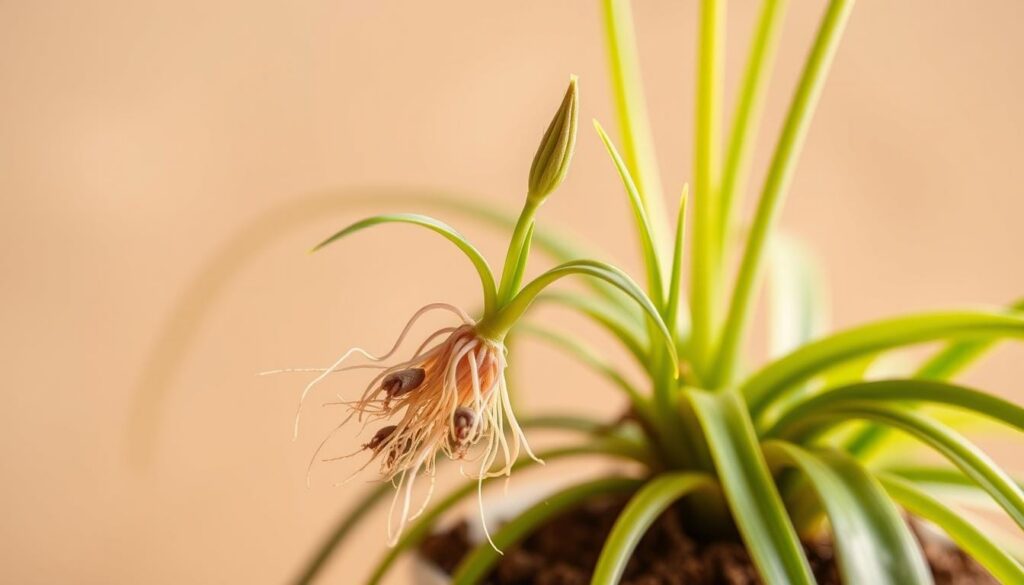
- A healthy spider plant produces 2–6 babies annually.
- Babies can be propagated while attached to the mother plant.
- Rootless cuttings may root in moist soil.
- Encourage new babies with indirect light and balanced fertilizer.
“Spider plants are resilient—most propagate easily with basic care,” says gardening expert Jane Green.
Learning spider plant propagation leads to years of lush greenery. Let these answers help you on your journey!
Cost-Effective Ways to Propagate Spider Plant Babies
Spider plant propagation doesn’t need to be expensive. You can use items from your home to save money. This way, anyone can grow new plants without spending a lot.
DIY Techniques
Use everyday items to start new plants:
- Egg cartons as mini pots for rooted offsets
- Plastic bottles cut into humidity domes for new shoots
- Popsicle sticks as supports for trailing stems
Using Home Supplies
Make common household items into tools for propagation:
- Cinnamon: Dust cuttings with this spice to prevent rot naturally
- Coffee filters: Line pots to improve drainage during soil propagation
- Gravel: Use as a base layer in containers for better water flow
| DIY Option | Commercial Equivalent | Cost Comparison |
|---|---|---|
| Egg carton seedling trays | Plastic seed trays | $0.50 vs $10 |
| Reused water bottles | Greenhouse kits | $0.25 vs $15 |
These methods save up to 90% compared to buying special equipment. With a bit of creativity, even beginners can grow more plants affordably. Every home has what you need for successful spider plant propagation.
Resources for Spider Plant Care
Learn more about spider plant care and spider plant propagation tips from trusted sources. These guides share expert advice on growing spider plant babies.
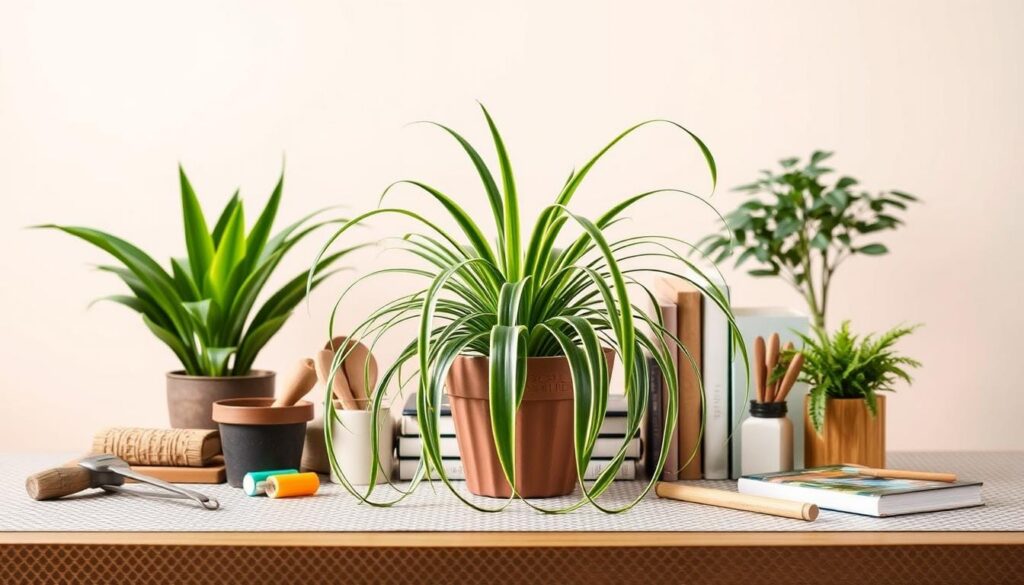
Recommended Books
- “The Complete Houseplant Survival Manual” by Barbara Pleasant: A detailed guide on how to care for spider plant babies.
- “Houseplants for Dummies” by Mike McGroarty: Provides step-by-step spider plant propagation tips and solutions to common problems.
- “The Plant Lover’s Guide to Houseplants” by Dr. David H. Trinklein: Discusses soil and light needs for healthy spider plant care.
Websites and Online Communities
Get help and accurate info from these websites:
- Missouri Botanical Garden: Offers in-depth guides on indoor plant care, including spider plant propagation tips.
- ASPCA Plant Toxicity List: Check if spider plants are safe for pets.
- Facebook Groups: “Spider Plant Enthuasiasts” for tips and success stories.
- PlantSnap App: Helps identify species and track your spider plant babies growth.
Conclusion: Enjoying Your Spider Plant Babies
Spider plant propagation is a rewarding journey. These plants are easy to care for and reproduce. You can grow them in water, soil, or by division.
They are perfect for any home because they are adaptable and low-maintenance. With a little care, you can enjoy lush foliage and more plants.
Final Thoughts on Care and Propagation
Keep your spider plant babies in bright, indirect light. Use well-draining soil to prevent waterlogged roots. Regularly check for pests and water them right.
Methods like clipping offsets or rooting in water work well. These plants grow fast, giving you new growth and babies over time.
Encouragement to Start Propagating
Don’t worry if you’re new to gardening. Spider plant propagation is easy. Start with a baby in a jar of water—roots will grow in weeks.
Once they’re established, move them to soil for more growth. Each new plant adds beauty and filters indoor air. Start small, learn as you go, and watch your collection grow.
The joy of nurturing life from a single baby is rewarding. Begin today to enjoy the benefits of spider plant babies in your home.
